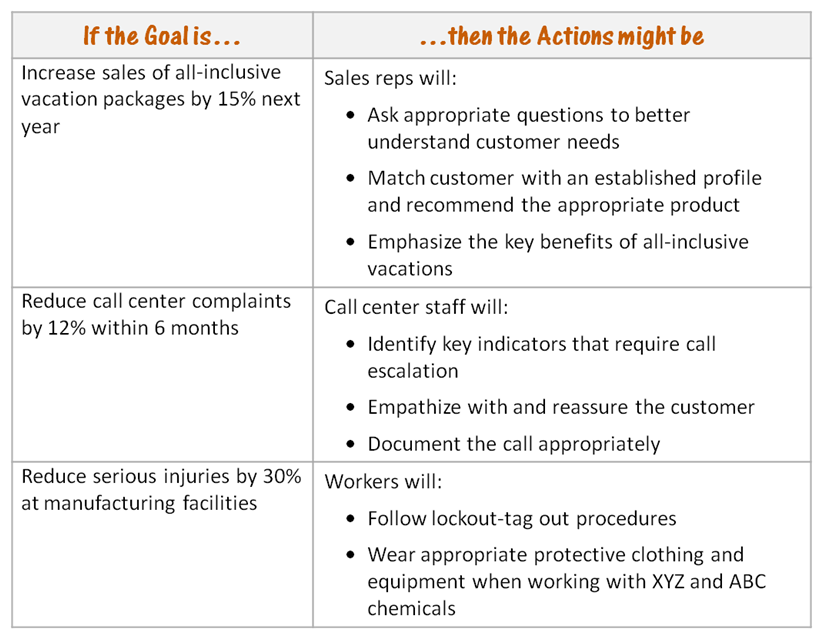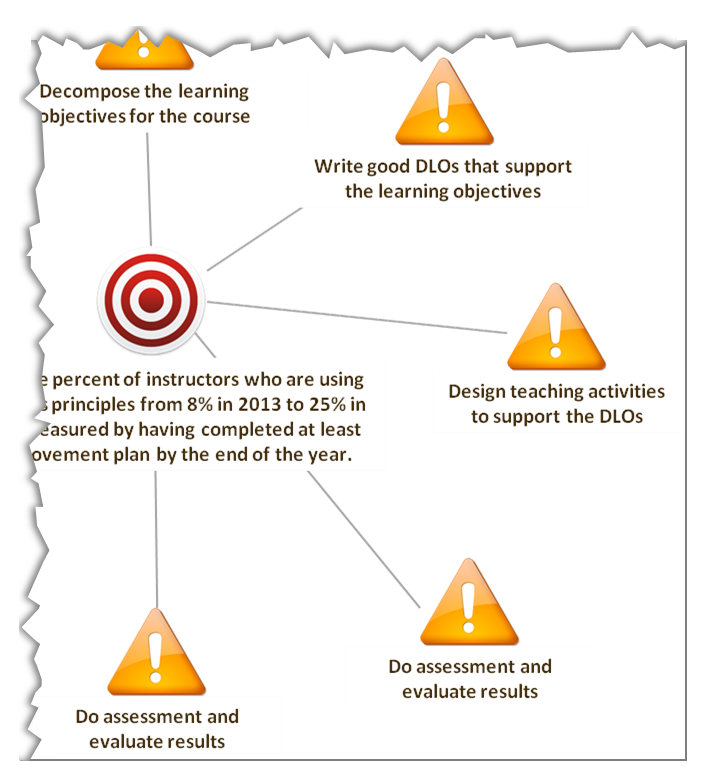This post is part of the Design Challenge series. If you need a refresher on our challenger or the project we are discussing, look at Design Challenge #1 – Part 1 of 4: Meet Our First Challenger.
Now that we have a SMART (Specific, Measurable, Attainable, Relevant, Time-bound) goal to aim for (“Increase the percentage of instructors who are using ChAMPIONs principles from 8% in 2013 to 25% in 2014, as measured by having instructors complete at least one improvement plan by the end of the year”), the next step is to identify the actions that learners must perform in the real-world to accomplish the goal. In other words, what must your learners DO?
When defining actions, run screaming from passive thinking statements like “Learners will UNDERSTAND the steps” and “Learners will KNOW the key parts of the Widget”; just because someone knows the weight or price or specifications of an XG900 widget, it doesn’t mean they know how to SELL, INSTALL or REPAIR an XG900. Instead, use active statements that imply the application of knowledge to a task. This will help you to create awesome, realistic activities that encourage performance in the real world.
Here are some examples of DOing, as opposed to thinking, action statements:
 Once you have identified what people need to DO, you may be tempted to start designing learning activities to enable learners to practice the actions you’ve identified. Don’t. Pause first to ask why aren’t people currently performing these actions? The goal of asking this question is to ensure that training is the best solution to the problem. Here are two examples where training may not be the best solution:
Once you have identified what people need to DO, you may be tempted to start designing learning activities to enable learners to practice the actions you’ve identified. Don’t. Pause first to ask why aren’t people currently performing these actions? The goal of asking this question is to ensure that training is the best solution to the problem. Here are two examples where training may not be the best solution:
- Example 1: Let’s say your business goal is to have sales reps sell more of all-inclusive vacation packages, which are more expensive and harder to sell than standard vacation packages. If agents receive the same commission for both types of vacations, even awesome training won’t make sales reps sell more all-inclusive vacations.
- Example 2: Sometimes a job aide is a less expensive and more effective solution than a training course. For example, if you need people to shred certain documents before they are recycled, a large poster above the recycling bin which identifies which document types require shredding will probably be a more effective solution than an elearning course that presents this information. Speaking of job aides, here’s one to help you decide when training is needed and when job aides are more appropriate
For this design challenge, we believe that the performance issues stem from a lack of skill in applying the ChAMPIONS principles, and therefore can be addressed with training via elearning, so let’s rock on…
Again, our stated goal for Design Challenge #1 is to “Increase the percentage of instructors who are using ChAMPIONs principles from 8% in 2013 to 25% in 2014, as measured by having instructors complete at least one improvement plan by the end of the year.” For this goal, the actions we came up with are:
- Decompose the learning objectives for the course
- Write DLOs (direct learning outcomes) that support the learning objectives
- Design teaching activities to support the DLOs
- Design assessments
- Teach
- Conduct assessments and evaluate results
- Conduct and evaluate peer review
- Document proposed actions
You may be wondering, how did we come up with these actions? In this project, we were lucky because our subject matter expert, Mia, is also an instructional designer and could provide this information fairly easily. However, in many situations, experts are so familiar with the topic that, although they can perform an action flawlessly, they have trouble explaining how they do it. In these situations, you may have to ask several probing questions, or, observe them on the job to really understand the required DOing actions.
Now that we’ve identified our actions we can map them to our performance objective. Here’s a snippet of our action map:
What are examples of actions you’ve identified for your elearning courses? What difficulties do you face when trying to write actions? Do you have examples of performance issues that were better addressed outside of elearning?
In the final blog post for Design Challenge #1, we’ll choose one of the above actions and start to develop some activity prototypes to help learners practice the skills they need to perform for the action.
DESIGN CHALLENGE
Read the Series
- Introducing the Elearning Design Challenge Series
- Part 1: Meet the First Challenger
- Part 2: Crafting a Goal
- Part 3: What Do You Want Learners to DO?
- Part 4: Create Learning Activities that Work

Leave a Reply